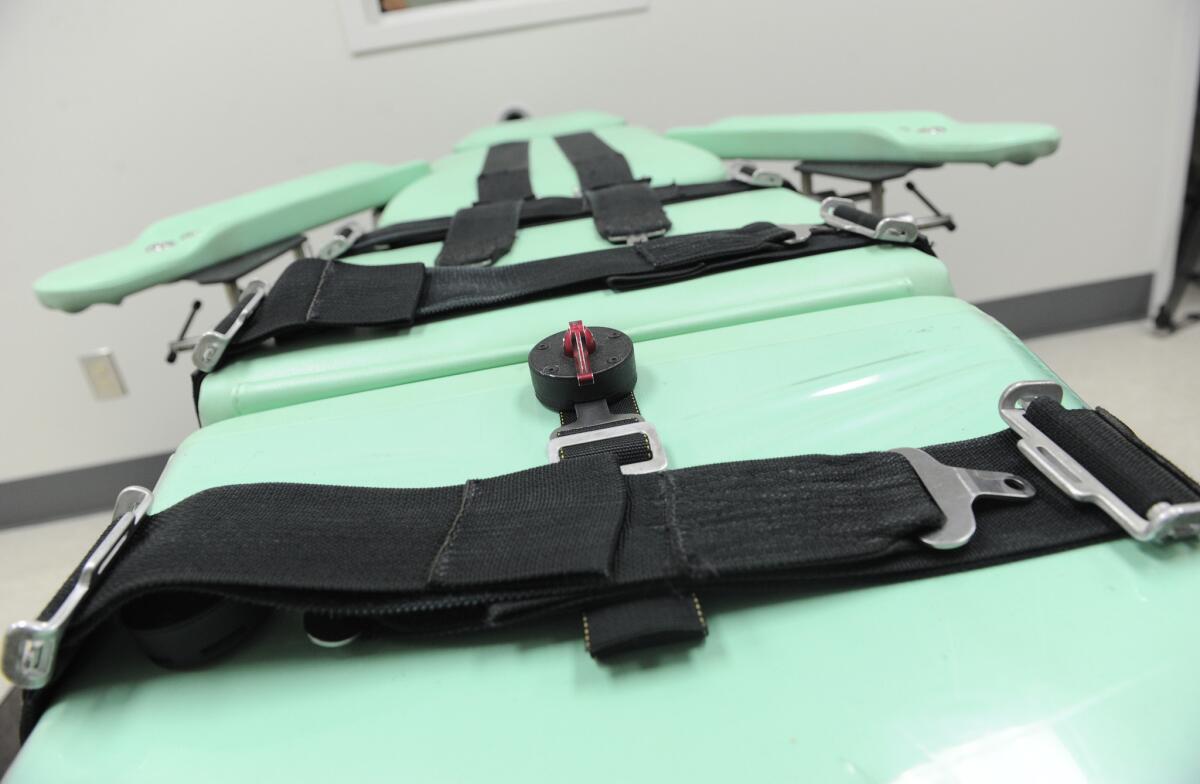California now under pressure to propose lethal injection method

- Share via
SAN FRANCISCO — The Supreme Court’s decision Monday giving a green light to an execution drug triggered a renewed attempt in California to create a single-drug method of lethal injection for inmates on America’s largest death row.
Under a legal settlement reached earlier this month, Gov. Jerry Brown’s administration agreed to propose a new lethal injection method 120 days after the Supreme Court decided a challenge to a lethal injection drug used in Oklahoma.
The decision came Monday in a 5-4 ruling that upheld the use of the drug, midazolam. The ruling reiterated that executions need not be painless and required inmates challenging methods to identify available alternatives that posed less risk of severe pain.
Kent Scheidegger, legal director of the pro-death penalty Criminal Justice Legal Foundation, said Monday’s ruling would make it more difficult for challengers to block California’s new protocol, which is due in late October.
“It is going to be very, very difficult — probably impossible — for anyone to get a stay” prohibiting the state from using the new method, Scheidegger said. “The decision was a home run.”
Brown’s administration agreed to the deadline after Scheidegger’s group sued on behalf of crime victims. Court rulings forced the state to revamp its executions plans, and more than three years have passed since Brown ordered prison officials to create a single-drug protocol.
Even with the new deadline, though, many hurdles remain before executions can resume in California.
State law requires extensive public comment on a new execution method, a process that could take a year.
Opponents of the death penalty also might decide to return to the ballot with a measure to replace the death penalty with life without parole. Voters narrowly defeated such a measure in 2012.
And drug manufacturers are making it increasingly difficult for prisons to obtain lethal drugs for executions.
Scheidegger and other death penalty supporters favor executing inmates with a lethal dose of pentobarbital, a drug that veterinarians use to euthanize animals.
Although Oklahoma complained that it no longer could get pentobarbital, any compounding pharmacy could make it, said Fordham University School of Law professor Deborah W. Denno, who has been studying lethal injection for two decades.
“You could build a pharmacy in your prison,” Denno said.
The Supreme Court’s decision could have unintended consequences, she said. She questioned, for instance, what would happen if a California inmate proposed a firing squad as an alternative to a single-drug lethal execution.
“In some ways, the decision has closed off doors but might be opening up other kinds of things that may not have been anticipated,” she said.
UC Berkeley law professor Elisabeth Semel — who heads a law school death penalty clinic that represents condemned inmates — said California will be unveiling a new execution method at time when there is “profound ambivalence about executions in this state.”
“We came very close to repeal,” she said.
Anyone who considers California’s resumption of executions “needs also to contemplate the fact that this means we are going to put to death 750 people” — the approximate number on death row — “which I don’t think anyone has the appetite for,” she said.
Although death penalty supporters applauded Monday’s ruling, Semel said the case underscored a profound division over the issue on the court. Justices Stephen Breyer and Ruth Bader Ginsburg suggested that the court should reexamine whether capital punishment itself is constitutional, given changed circumstances and new evidence.
In a dissent joined by Ginsburg, Breyer cited “increasingly lengthy delays” of several decades between conviction and execution, passages of time that he said undermine arguments that executions deter crimes. Inmates on death row in California are more likely to die of old age than the executioner’s needle.
A case now before the U.S. 9th Circuit Court of Appeals will determine whether the decades-long delays in executions in California render the state’s system unconstitutional.
U.S. District Judge Cormac J. Carney, an appointee of former President George W. Bush, cited the delays and the arbitrary nature of executions in a ruling last summer that declared California’s death penalty unconstitutional.
Atty. Gen. Kamala D. Harris appealed, and a three-judge panel will hear arguments in August.
Ana Zamora, a lawyer with the ACLU of Northern California, said opponents of the death penalty are weighing all options, including another ballot measure. Even with the death penalty on the books, California is likely to have trouble enforcing it, she said.
“The state has spent the last 10 years trying to create a legally sound execution protocol, but they have failed repeatedly,” she said. “There is no evidence to suggest that this time around will be any different.”
Twitter: @mauradolan
More to Read
Sign up for Essential California
The most important California stories and recommendations in your inbox every morning.
You may occasionally receive promotional content from the Los Angeles Times.











